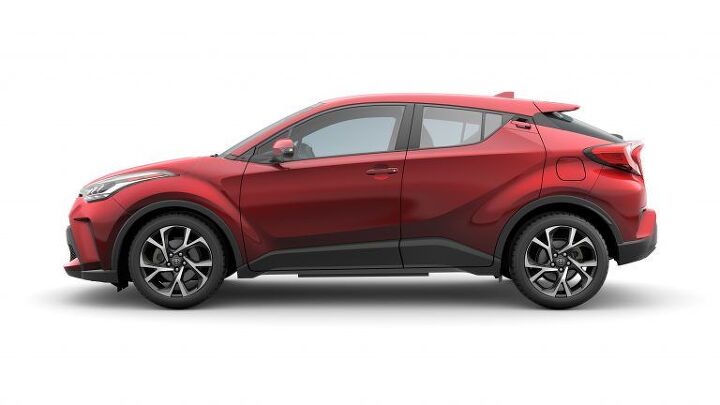Toyota Updates C-HR for 2020; Power and Drive Wheels Carry Over

If you were hoping that a refresh bestowed upon Toyota’s funky subcompact crossover would yield the extra oomph and all-wheel drive desired by many since the model’s debut, well, re-read that headline.
For 2020, C-HR buyers will continue to get by with front-drive and a 144-horsepower 2.0-liter four-cylinder; they’ll just gain some appearance and content changes. Truth be told, FWD and a tepid four is probably fine for the majority of subcompact crossover buyers. However, take a trip overseas and you’ll find there’s suddenly extra power on offer.
In Europe, and coming soon to Australia, C-HR shoppers will have access to a 181 hp hybrid variant appearing for the 2020 model year. But that’s over there, and you’re stuck over here.
The lack of North American powertrain enhancements for the model’s refresh is surely a decision in which dollars and cents played a big role. Overseas, depending on market, the C-HR is offered as a hybrid, an electric vehicle (China, starting next year), and an all-wheel drive product. Introduced for 2018, the C-HR turned heads with its avant-garde styling and gave Toyota an answer to Honda’s HR-V, Mazda’s CX-3, and General Motors’ Trax/Encore twins.
Toyota’s recent admission to Car and Driver that a joint Alabama assembly plant shared with Mazda will breed a new crossover has only added fuel to the rumor fire. Will the C-HR bow out of the American market in favor of a tailor-made crossover solution, or will it soldier on while a newer and larger lineup addition soaks up the spotlight? The latter scenario makes more sense.
But back to the 2020 C-HR. For the coming model year, the model gains a reworked fascia that gives the impression of a larger mouth, plus LED headlamps — even on the lower-rung LE model. A new spoiler appears out back. To tempt the younger crowd, Android Auto comes aboard as the (glaring) missing piece of the vehicle’s connectivity suite.
Elsewhere, the changes are minor and trim-specific. Limited models gain a new eight-way power driver’s seat and adaptive headlights that swivel into turns. There’s seatback pockets and sun visor extensions to be found on the XLE. Buyers of the LE can expect a new headliner. All trims gain new wheel designs. While two new colors join the C-HR’s palette, you’ll no longer be able to order a white roof. Silver replaces white for 2020, you see.
Small things, to be sure, but despite the status quo powertrain and running gear, Toyota isn’t content to keep things exactly the same. Thus far, the C-HR’s sales performance hasn’t suffered from a lack of updates, though its popularity seems limited by the lack of all-wheel grip. U.S. volume through September is basically flat, down 0.4 percent from the same period a year earlier.
It’s worth noting that Honda’s HR-V reached the C-HR’s current sales tally before the end of May.
[Images: Toyota]

More by Steph Willems
Latest Car Reviews
Read moreLatest Product Reviews
Read moreRecent Comments
- Kwik_Shift_Pro4X The dominoes start to fall...
- IBx1 Get the standard established, then stop building the chargers while you let others license the design from you to build more stations with your standard disgusting
- IBx1 “Dare to live more”-company that went from making the Countach and Diablo to an Audi crossover with an Audi engine and only pathetic automatic garabge ”live mas”-taco bell
- Pianoboy57 Not buying one of these new when I was a young guy was a big regret. I hated the job I had then so didn't want to commit to payments. I did own a '74 Corona SR later for a short time.
- FreedMike This wasn’t unpredictable. Despite what the eV HaTerZ kLuBB would like you to believe, EV sales are still going up, just not as quickly as they had been, but Tesla’s market share is down dramatically. That’s the result of what I’ve been saying for a long time: that the competition would eventually start catching up, and that’s exactly what’s happening. How did this happen? It boils down to this: we’re not back in 2019 anymore. Back then, if you wanted an EV that wasn’t a dorky looking ecomobile like a Leaf or Bolt, it was pretty much Tesla or bust, and buyers had to deal with all the endemic Tesla issues (build quality problems, bizarre ergonomics, weird styling, and so forth). That’s not the case today – there is a ton of competition, and while these newer models aren’t quite there when it comes to EV tech, they’re getting closer, and most of the Tesla weirdness just doesn’t apply. And then there’s this: stale product is the kiss of death in the car biz, and aside from the vanity project known as Cybertruck, all of Tesla’s stuff is old now. It’s not as “bleeding edge” as it used to be. For a company that made its’ bones on being on the forefront of tech, that’s a big problem.I don’t think Tesla is out of the game – not by a long shot. They’re still the market leader by a very wide margin, and their EV tech is the best in the game. But they need to stop focusing on stuff like the Cybertruck (technically fascinating, but it’s clearly an Elon Musk ego trip), the money/talent suck that is FSD, and the whole robotaxi thing, and put product first. At a minimum, everything they sell needs a very heavy refresh, and the entry level EV is a must.




































Comments
Join the conversation
There's one of these in my area and it, uhhh, stands out being some version of light blue with a white roof. Like a Smurf.
This thing has the absolute worst rear corner visibility of any vehicle I've ever sampled.